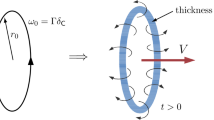Abstract
Arational asymptotic theory is proposed,which describes the turbulent dynamic and thermal boundary layer on a flat plate under zero pressure gradient. The fact that the flow depends on a finite number of governing parameters makes it possible to formulate algebraic closure conditions relating the turbulent shear stress and heat flux with the gradients of the averaged velocity and temperature. As a result of constructing an exact asymptotic solution of the boundary layer equations, the known laws of the wall for velocity and temperature, the velocity and temperature defect laws, and the expressions for the skin friction coefficient, Stanton number, and Reynolds analogy factor are obtained. The latter makes it possible to give two new formulations of the temperature defect law, one of which is identical to the velocity defect law and contains neither the Stanton number nor the turbulent Prandtl number, and the second formulation does not contain the skin friction coefficient. The heat transfer law is first obtained in the form of a universal functional relationship between three parameters: the Stanton number, the Reynolds number, and the molecular Prandtl number. The conclusions of the theory agree well with the known experimental data.
Similar content being viewed by others
References
B.A. Kader and A.M. Yaglom, “Similarity Laws for Turbulent Near-Wall Flows,” in: Advances of Science and Engineering. Ser. Mechanics of Fluid and Gas. V. 15 [in Russian] (VINITI, Moscow, 1980), pp. 81–155.
J. Blom, An ExperimentalDetermination of the Turbulent Prandtl Number in a Developing Temperature Boundary Layer, (PhD Thesis, Technische Hogeschool, Eindhoven, 1970).
A. Zhukauskas and A. Shlanchauskas, Heat Transfer in Turbulent Flow (Ed. A. Zhukauskas) [in Russian] (Mintis, Vilnus, 1973).
P.H. Hoffmann and A.E. Perry, “The Development of Turbulent Thermal Layers on Flat Plates,” Int. J. Heat Mass Transfer 22, 39–46 (1979).
T. von Kármán, “Mechanische Ähnlichkeit und Turbulenz,” in: Proc. 3rd Intern. Congress Applied Mechanics, Stockholm, 24–29 August 1930. V. 1 (Eds. C.W. Oseen and W. Weibull) (Stockholm: Aktiebolaget Sveriges Litografiska Tryckerier, 1931), pp. 85–93.
I.I. Vigdorovich, “Similarity Laws for Velocity and Temperature Profiles in theWall Region of a Turbulent Boundary Layer with Injection and Suction,” Doklady Physics, 48 (9), 528–532 (2003).
I.I. Vigdorovich, “Self-Similar Boundary Layer with Imposed Pressure Gradient. Velocity-Defect Law,” J. Exp. Theor. Phys. 117 (2), 356–368 (2013).
I.I. Vigdorovich, “Self-Similar Turbulent Boundary Layer with Imposed Pressure Gradient. Four Flow Regimes,” J. Exp. Theor. Phys. 119 (5), 933–957 (2014).
I.I. Vigdorovich, “Asymptotic Analysis of Turbulent Boundary Layer Flow on a Flat Plate at High Reynolds Numbers,” Fluid Dynamics 28 (4), 514–523 (1993).
J.B. Bell, Heat Transfer to Turbulent Boundary Layers in Pressure Gradients (M.S. Thesis, Univ. Melbourne, 1966).
D.G. Whitten, W.M. Kays, and R.J. Moffat, The Turbulent Boundary Layer on a Porous Plate: Experimental Heat Transfer with Variable Suction, Blowing and Surface Temperature, (Rep. HMT-3, Stanford Univ, 1967).
B.F. Blackwell, W.M. Kays, and R.J. Moffat, The Turbulent Boundary Layer on a Porous Plate: an Experimental Study of the Heat Transfer Behavior with Adverse Pressure Gradients, (Rep. No. HMT–16, Stanford Univ., 1972).
W.M. Kays, “Turbulent Prandtl Number—Where Are We?” J. Heat Transfer 116 (2), 284–295 (1994).
I.I. Vigdorovich, “Velocity, Temperature, and Reynolds-Stress Scaling in the Wall Region of Turbulent Boundary Layer on a Permeable Surface,” J. Exp. Theor. Phys. 99 (5), 1028–1038 (2004).
M. Van Dyke, Perturbation Methods in Fluid Mechanics (Acad. Press, New-York, London, 1964).
F.H. Clauser, “The Turbulent Boundary Layer,” in: Advances in Applied Mechanics. V. 4 (Eds. H.L. Dryden and T. Karman) (Acad. Press, New York, 1956), pp. 1–51.
D. Coles, “The Law of the Wake in the Turbulent Boundary Layer,” J. Fluid Mech. 1 Pt 2, 191–226 (1956).
T. Cebeci and P. Bradshaw, Physical and Computational Aspects of Convective Heat Transfer (N. Y.: Springer-Verlag, New-York, 1984).
P.S. Andersen, W.M. Kays, and R.J. Moffat, The Turbulent Boundary Layer on a Porous Plate: An Experimental Study of the Fluid Mechanics for Adverse Free–Stream Pressure Gradient (Rep. HMT–15, Stanford Univ., 1972).
A.E. Perry, J.B. Bell, and P.N. Joubert, “Velocity and Temperature Profiles in Adverse Pressure Gradient Turbulent Boundary Layers,” J. Fluid Mech. 25, 299–320 (1966).
R.L. Simpson, R.J. Moffat, and D.G. Whitten, “An Experimental Study of the Turbulent Prandtl Number of Air with Injection and Suction,” Int. J. Heat Mass Transfer 13 (1) 125–143 (1970).
M.V. Zagarola and A.J. Smith, “Mean-Flow Scaling of Turbulent Pipe Flow,” J. Fluid Mech. 373, 33–79 (1998).
X. Wang and L. Castillo, “Asymptotic Solutions in Forced Convection Turbulent Boundary Layers,” J. Turbulence 4, 006 (2003).
X. Wang, L. Castillo and G. Araya, “Temperature Scalings and Profiles in Forced Convection Turbulent Boundary Layers,” J. Heat Transfer 130, 021701-1–17 (2008).
Author information
Authors and Affiliations
Corresponding author
Additional information
Original Russian Text © I.I. Vigdorovich, 2017, published in Izvestiya Rossiiskoi Akademii Nauk, Mekhanika Zhidkosti i Gaza, 2017, No. 5, pp. 38–52.
Rights and permissions
About this article
Cite this article
Vigdorovich, I.I. Turbulent thermal boundary layer on a plate. Reynolds analogy and heat transfer law over the entire range of prandtl numbers. Fluid Dyn 52, 631–645 (2017). https://doi.org/10.1134/S0015462817050052
Received:
Published:
Issue Date:
DOI: https://doi.org/10.1134/S0015462817050052




